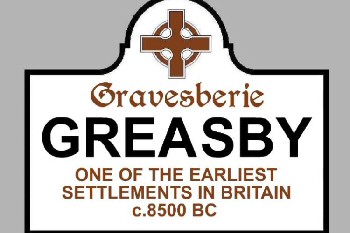|
Greasby - showing signs of old age

THE origins of a Wirral village have
been found to be around 6,000 years older than Stonehenge and the Pyramids. A
series of new boundary signs are to be unveiled next week that proclaim that the
township of Greasby contains the earliest dated settlement in Western Britain;
and 1 of the oldest in the country.
Acknowledging the historical significance of Greasby with these signs has long
since been an aspiration of former Liverpool City Centre planning team leader,
Rod Hutchinson.
His ambition has been made possible now thanks to community funding through the
Western Link project, the ₤1 billion venture between National Grid and Scottish
Power Transmission that will being renewable energy from Scotland to homes and
businesses in England and Wales and which runs through parts of Wirral.
Rod said:- "After 12 years of endeavour, I'm delighted that these
place-name signs have at last been realised. Greasby's amazing history is worth
celebrating both locally and nationally."
The new signs have been designed by Rod and have been manufactured by the
leading sign makers, Leander Architectural of Buxton. Their installation was
supervised by Wirral Council's Senior Assistant Engineer, Ian White.
The work that led to the latest 'dating' of Greasby began with
excavations near Greasby Copse, between 1987 and 1990, by archaeologists from
Liverpool Museum. They uncovered a substantial settlement with stone floor,
pits, large working hollows and a fireplace together with over 12,000 early
stone tools. At that time, the site was dated at 7000 BC or earlier and ascribed
to the Mesolithic period.
However, as a result of the proposals for the signs to celebrate Greasby's
significant historical status, Ron Cowell, Curator of Prehistoric Archaeology at
the Museum of Liverpool, raised further funds for carbon dating of hazelnut
shells found in the stone hearth. Astonishingly, this revealed that the remains
were even earlier than previously estimated and dated from around 8,500BC.
This adds weight to James Dyer's belief, as stated in his book 'Ancient
Britain' that the structure discovered at Greasby:- "seems almost
certainly to be the earliest dwelling found in Britain." Regarding the origins of the name Greasby, the Survey of English Place Names
concludes that:- "no certainty of the meaning of the name is possible".
Over the centuries it has been written:- Greavesberi, Grausberi, Grauesbyri,
Grausby, Grauesbi, Greseby, Greisbie and Gresbie.
However it seems the name is of Anglo Saxon origin as it occurs in the Domesday
Book as Gravesberie, possibly deriving from the Old English, Graefes burh, 'the
Castle of Graef' or "stronghold at a wood or grove."
Greasby was on the postulated important Roman road from Chester to Meols, where
Roman remains such as coins, jewellery and weapons, have been found. Excavations
in Greasby village in 1965 established that Barker Lane was of Roman origin
although official confirmation of that was not possible until around 1980.
In addition to Western Link's support for the signs, ₤750 was donated from the
Wirral West Community Fund and ₤750 from Greasby Community Association to cover
the costs of installation.
Chair of the Wirral West Constituency Committee, Cllr Jeff Green, said:-
"We are proud to have one of the oldest confirmed settlements in the country on
our doorstep and delighted to have been able to support the signage project with
funding. Now everyone who visits or passes through Greasby will know the
significance of the village." The unveiling of one of the 5 signs will be at 11am, on Thursday, 28 September
2017, outside the Premier Inn, on Greasby Road, Greasby, Wirral, CH49 2PP.
|
